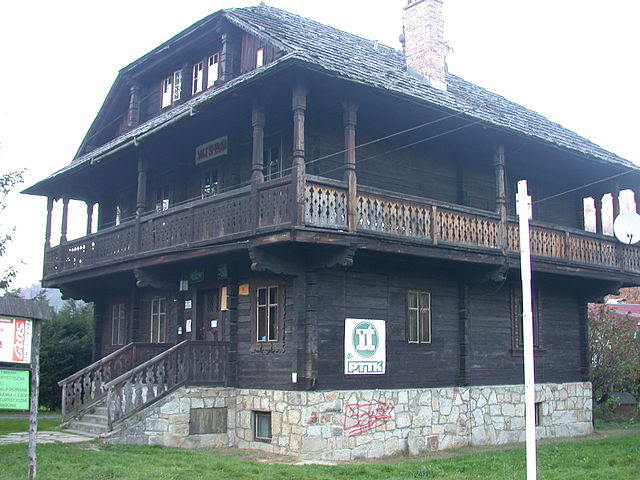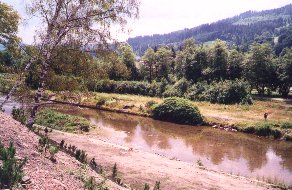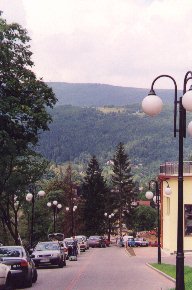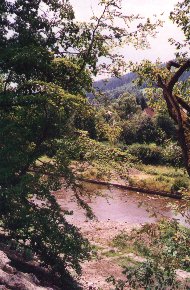Wisła

Habsburg genus hunting lodge in Wisła. – Photo by: Pudelek to Polish Wikipedia, Vistula PTTK, CC BY-SA 2.5
Distance
Population
12.000 (2004)

The river Wisła in the town of Wisła
Location and history
The town of Wisła is located in the mountain region Beskid Śląski, in the branched Wisła River Valley. The very elongated urban area includes the area where the sources of the river Wisła are located. From the springs of the Barania Góra mountain flow the mountain streams Czarna Wisełka and Biała Wisełka, which unite and further absorb the water from the Malinka basin, forming together the river Wisła, Poland's largest river.
Many houses, both year-round and summer houses, are located outside the center of the side valleys, such as Malinka, Gościejów, Partecznik, Głębce, Łabajów, Dziechcinka, Jawornik and Gahura as well as on the slopes of the surrounding mountains: Wierch Skolnity, Kamienny, Kobyny, Kobyny, Kobyny .
The city center is on average 430 meters above sea level. The highest points are Barania Góra (1220 meters) and Stożek (978 meters).
The inhabitants are Silesian mountain dwellers. A characteristic feature of the population here is its affiliation with several different faith communities. The Protestant faith dominates; ca. 50% of the population belongs to the Evangelical-Augsburg Church, while about 30% are Catholics.
The first written testimony of the village of Wisła dates from 1615. The town first gained market town rights in 1962.
Interest in Wisła as a holiday village began in earnest at the transition between the 19th and 20th centuries, when the first summer villas were built and the first boarding houses arose.
After World War II, the development of the city accelerated as a resort. Wisła was to serve as a holiday center for the whole of Upper Silesia and not least for the nearby large industrial areas (Katowice area). Numerous company-holiday centers were built and a better road connection to Katowice was established.
75% of the area of the municipality is covered by forest. The most beautiful woodlands are found in the Barania Góra nature reserve of 383 ha, established in 1953. The mountain streams Czarna and Biała Wisełka as well as Malinka are brook trout reserves.
Several tourist trails allow you to visit the reserves from spring to autumn, and in winter you can ski there. There is also a so-called didactic hiking trail at Barania Góra, where tourists can learn something about the natural values of the area as well as about the human influence on nature.


Tourist attractions
In Wisła stands approx. 100 km of tourist routes available to visitors. In the summer you can use the hiking and biking trails (of varying difficulty), in the winter the beautiful ski routes, ski lifts and ski slopes. An outdoor pool, several tennis courts and other sports facilities are available in summer.
The old inn from 1794 – now a museum. Located at ul.Stellera.
Several old wooden buildings , Among other things. a 1891 wood-built school.
The Evangelical Church from 1838, an example of classicist architecture.
The old school from 1824.
Hotel Piast , the first hotel in the city, built around 1885.
Habsburg Hunting Citizens from 1897.
The Catholic Church from 1855, remodeled in 1970 (ul. Lipowa).
Wooden built villas from the beginning of the 20th century. (among others by al.Burschego).
Accommodation
Booking.com
Wisła The city's official site – with practical information for tourists
Eating Out:
Wisła The city's official site – with practical information for tourists
Other Internet sites and sources
Wisła The city's official site
Translated into English by Google Translate. Spangshus.dk accept no liability for any errors or omissions in translation.
Map

Rating
Search
Most used tags
churches (205) Castles (86) Monasteries (79) Town walls (74) Lakes (71) Town halls (67) Rivers (65) Castles1 (62) Mansions (55) Museums (51) Regional museums (38) Town gates (36) Abbey churches (35) Castle ruins (30) Cathedrals (26) Forests (25) Health resorts (24) Mounds (23) Water sports (23) National parks (22)Click for all tags
Denne side er også tilgængelig på dansk. This page and contents is (c) Copyright 2018- www.spangshus.dk. Based on Inviator software by ISCA Software